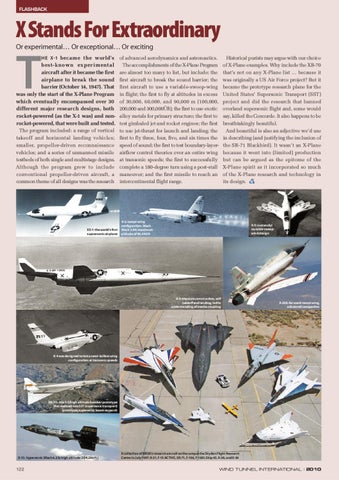FLASHBACK
X Stands For Extraordinary
t
Or experimental… Or exceptional… Or exciting he X-1 became the world’s
of advanced aerodynamics and astronautics. The accomplishments of the X-Plane Program are almost too many to list, but include: the first aircraft to break the sound barrier; the first aircraft to use a variable-sweep-wing in flight; the first to fly at altitudes in excess of 30,000, 60,000, and 90,000 m (100,000, 200,000 and 300,000Üft); the first to use exotic alloy metals for primary structure; the first to test gimbaled jet and rocket engines; the first The program included: a range of vertical to use jet-thrust for launch and landing; the takeoff and horizontal landing vehicles; first to fly three, four, five, and six times the smaller, propeller-driven reconnaissance speed of sound; the first to test boundary-layervehicles; and a series of unmanned missile airflow control theories over an entire wing testbeds of both single and multistage designs. at transonic speeds; the first to successfully Although the program grew to include complete a 180-degree turn using a post-stall conventional propeller-driven aircraft, a maneuver; and the first missile to reach an common theme of all designs was the research intercontinental flight range.
Historical purists may argue with our choice of X-Plane examples. Why include the XB-70 that’s not on any X-Plane list … because it was originally a US Air Force project? But it became the prototype research plane for the United States’ Supersonic Transport (SST) project and did the research that banned overland supersonic flight and, some would say, killed the Concorde. It also happens to be breathtakingly beautiful. And beautiful is also an adjective we’d use in describing (and justifying the inclusion of the SR-71 Blackbird). It wasn’t an X-Plane because it went into (limited) production but can be argued as the epitome of the X-Plane spirit as it incorporated so much of the X-Plane research and technology in its design.
best-known experimental aircraft after it became the first airplane to break the sound barrier (October 14, 1947). That was only the start of the X-Plane Program which eventually encompassed over 30 different major research designs, both rocket-powered (as the X-1 was) and nonrocket-powered, that were built and tested.
XS-1: the world’s first supsersonic airplane
X-2: swept-wing configuration. Mach Mach 2.44; maximum altitude of 90,440 ft
X-5: successful variable sweepwind design
X-3: titanium construction, self takeoff and landing, led to understanding of inertia coupling
X-29A: forward-swept wing, advanced composites
X-4 was designed to test a semi-tailless wing configuration at transonic speeds
XB-70: Mach 3/high altitude bomber prototype that evolved into SST (supersonic transport) prototype; supersonic boom research
X-15: hypersonic (Mach 6.33); high altitude (354,200 ft.)
122
A collection of NASA’s research aircraft on the ramp at the Dryden Flight Research Center in July 1997: X-31, F-15 ACTiVE, SR-71, F-106, F-16XL Ship #2, X-38, and X-36
WIND TUNNEL INTERNATIONAL | 2010
